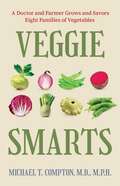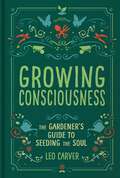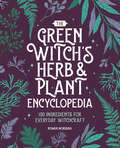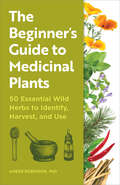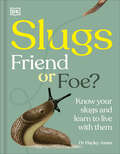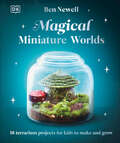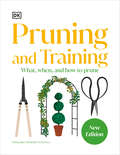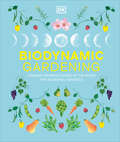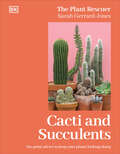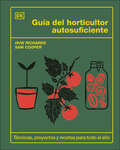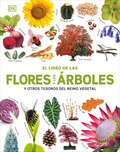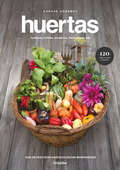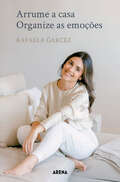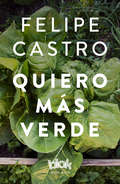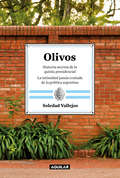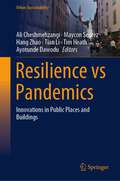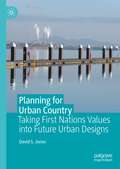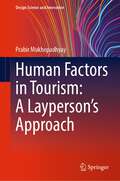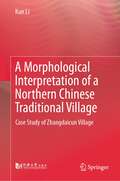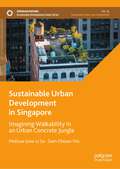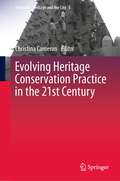- Table View
- List View
Dopamine Decor: Alter Your Space, Alter Your Mood
by Kate Rose MorganEmbrace colorful, maximalist style and create the home that makes you happy with Dopamine Decor, a lushly photographed ode to joyful interiors from design expert and social media star Kate Rose Morgan. Find your color confidence with Dopamine Decor, an aspirational yet practical guide to vibrant, maximalist style. Throughout this playful, joy-filled book, design expert and proud color lover Kate Rose Morgan (@kate_rose_morgan) teaches readers of all kinds how to channel the aesthetic that makes them happy, to create the homes of their dreams. Inside you'll find: Guidelines for finding your comfort color and design vision. Ways to connect with your "inner child" as you hone your aesthetic and find joy. Practical guidance on paint, DIY projects, and achieving balance. Tips for both homeowners and renters on how to brighten up any space. Budget-friendly ideas for introducing playfulness into your home. Inspirational images from dozens of colorful homes around the world. Personal stories from Kate's own colorful home transformation.
Family Handyman DIY Trade Secrets: EXPERT ADVICE BEHIND THE REPAIRS EVERY HOMEOWNER SHOULD KNOW (Family Handyman)
by Family HandymanIntroducing DIY Trade Secrets, the ultimate guide to transforming your home with expert advice from the pros at Family Handyman magazine! Created by the team known for a commitment to quality, craftsmanship and overall DIY awesomeness, this must-have book is a treasure trove of fix-it knowledge for today's homeowners. Master the secrets behind hundreds of floor-to-ceiling improvements guaranteed to save money on service calls. From painting, drywalling and electrical work to carpentry and automotive and roof repairs, the projects in this incredible resource couldn&’t be easier to follow. You&’ll even find expert tips on lawn care and storage as well as the maintenance techniques that keep homes running smoothly. Whether you're a seasoned DIYer or a newbie, DIY Trade Secrets is the trusted companion every homeowner needs! Don't miss your opportunity to cut costly repair bills, improve your know-how and turn living spaces into thumbs-up showrooms. Grab a copy of Family Handyman DIY Trade Secrets today and tackle your home-improvement projects with speed, savings and success. SELLING POINTS: Hundreds of projects, repairs, hints and tips to keep your home and yard in top-notch shape without costly service calls. Expert advice from today&’s repair professionals as well as the trusted team at Family Handyman magazine. Step-by-step directions for every home project, including electrical updates, woodworking, door and window repair, painting and staining, and more. Bonus advice regarding lawn care, automotive maintenance and storage suggestions. CHAPTERS Painting & Finishes Cabinetry Floors, Ceilings & Walls Doors, Windows & Trim Remodeling, Energy Saving & Electricity Exterior Lawn & Paving Garage & Automotive
Family Handyman Whole House Budget Friendly DIY: Save money, save time, slash household bills. It's easy with help from the pros. (Family Handyman Whole House)
by Family HandymanPacked with the expert, step-by-step guidance from the page of &“Family Handyman&” magazine, Whole House Budget-Friendly DIY will help you save big when it comes to your home.With Family Handyman Whole House Budget-friendly DIY, you&’ll find transformative projects that make every room in your house look like a million bucks. Follow the step-by-step instructions and detailed diagrams as you affordably transform your kitchen counters, build timeless furniture pieces, add elegant trim to walls, update outdoor living spaces and so much more. You&’ll also learn how to make cost-effective repairs to your air conditioner, sprinkler system, toilets and car to avoid pricey service calls. Plus, don&’t miss the bonus chapter that features tips from industry experts on how to slash household bills, including water, electricity and even insurance. Think big and spend small with Whole House Budget-Friendly DIY.
Veggie Smarts: A Doctor and Farmer Grows and Savors Eight Families of Vegetables
by Michael T. ComptonA nerdy farmer—and doctor with expertise in nutrition—explains how the vast majority of our vegetables come from just eight families of plants, which can guide how we eat them (&“eight on my plate&”), while recounting his journey of trading in city life to build a thriving organic vegetable farm.Dr. Michael Compton shares his passionate and healthy approach to savoring vegetables daily from across eight veggie families: the Brassicas, the Alliums, the Legumes, the Chenopods, the Aster Greens, the Umbellifers, the Cucurbits, and the Nightshades. Trading in city life for an old stone house and a fertile field in the scenic and historic Hudson Valley of New York, Compton built a compact, organic-certified vegetable, fruit, and flower farm. Compton shares lighthearted scientific facts, including why onions make us cry and how beets can make our pee pink, while providing nutritional information about the eight families of vegetables. As a farmer, he recounts growing a bounty of clean, delicious, and nutritious food for himself and so many others, and shares his exploration of those who farmed the land before him. You will delight in following his rewarding but sometimes frustrating efforts to reclaim old farmland for new adventures in organic farming. You might even find yourself wanting to test the greenness of your thumbs or to determine whether or not you too, are a natural-born berry picker. This is a deeply personal celebration of growing and savoring life…and vegetables.
Growing Consciousness: The Gardener's Guide to Seeding the Soul
by Leo CarverGrowing Consciousness explores the links between spirituality and the garden with a focus on Ayurvedic techniques and meditation. Through simple daily meditation practices coupled with gardening, you can marry spiritual growth and plant-based consumption to cultivate a more gratifying existence.This book forges an accessible path to self-discovery and truth; one that can apply to a small herb garden on the windowsill just as well as it would to a Buddhist Zen garden. Growing Consciousness will outline simple practices and explorations into the spiritual qualities of gardening and how one can marry spiritual growth and plant-based consumption to cultivate a more conscious and satisfying existence.
The Green Witch's Herb and Plant Encyclopedia: 150 Ingredients for Everyday Witchcraft
by Rowan MorganaEverything you need to know about using plants and herbs for green witchcraftInfusing your craft with plants and herbs is a powerful way to connect to Mother Earth. This green witchcraft encyclopedia explores the most essential magical plants, offering you a complete resource for safely growing, foraging, harvesting, and using everything from aloe to valerian. Discover greater harmony with nature as you harness the natural energy of plants to create healing and balance in your life.150 plant profiles — Find detailed entries for the plants and herbs green witches use the most, including photos, explanations of each plant's magical properties, and tips for how to grow them yourself.Herb magic in action — Experience the power of plant magic with spells and rituals to try, such as banishing negativity with catnip and clover or building a fairy altar with foxglove and thyme.Embrace your inner witch — Part reference guide and part grimoire, this book of herbs helps you develop your practice by exploring how to set intentions, create a sacred space, and maintain your own garden.Start your own witch's apothecary and create some everyday magic with this encyclopedia of magical herbs and plants.
The Beginner's Guide to Medicinal Plants: 50 Essential Wild Herbs to Identify, Harvest, and Use
by Amber Robinson PhDCreate healing remedies with nature's help Our planet is home to an abundance of powerful plants that can help you heal gently and naturally. In this beginner's guide, you'll learn how to find, harvest, and prepare some of the most common medicinal plants and use them to create restorative remedies—from a burdock tea for clearer skin to a cayenne pepper salve for better blood flow. Get to know the plants—Discover profiles of 50 essential plants, herbs, and roots, complete with photos and an overview of their unique medicinal properties. Teas, tinctures, and tonics—Put each plant to use with simple recipes for soothing poultices, energizing bath soaks, and so much more. Stay smart and safe—Learn how to properly identify plants, as well as how to use the Universal Edibility Test to check that what you find is safe to consume. Your journey to homemade herbalism starts here.
Slugs: Know Your Slugs and Learn to Live with Them
by Royal Horticultural SocietyAre slugs and snails wreaking havoc in your garden? Do you want to nip the problem in the bud but don't know how without resorting to harmful pesticides?Every gardener shares the same struggle. But what if not all slugs deserve the bad rap in your garden?Discover everything you need to know about slugs: the different species, their fascinating life cycles, and the important role they play in your garden ecosystem. Learn which slugs are busy recycling decaying matter and which ones have your precious seedling firmly on their menus, as well as the practical steps you can take to control them with eco-friendly measures.Think you know slugs? Think again. Let the experts help you become friends with mollusks with Slugs: Friend or Foe?
Magical Miniature Worlds: 18 Terrarium Projects for Kids to Make and Grow
by Ben NewellJoin expert Ben Newell and learn how to create your own tiny world in this children’s terrarium book.This plant book for children aged 7-9 offers practical instructions and loads of exciting ideas for making your own terrarium.Ben Newell clearly explains every step of creating your own terrarium, from picking a container to creating a landscape and choosing the right plants. Once you've mastered the basics, you can let your imagination run wild with these miniature gardens that can be grown in anything from fish tanks to spice jars.This gardening book for kids offers: Content made by terrarium expert Ben Newell. 18 terrarium projects that can be made in any space or environment. Clear, practical guidance and step-by-step instructions on how to build a terrarium.A variety of projects that are themed, including a fairy house, alien landscape, and egg hunt.Why not build a prehistoric jungle complete with dinosaurs? Or a delicate fairy garden? Maybe even an alien world? With 18 different projects to inspire you, you'll be filling your shelves in no time. As well as building terrariums, you'll discover how they work, including all about friendly soil creatures and the water cycle. By learning some of the science behind terrariums, you'll make sure that yours thrives.
Pruning and Training: What, When, and How to Prune
by DKCut with confidence: know when and how to prune your trees and plants with this complete guide from the experts.Keep your garden in top shape with this guide to pruning over 800 plants, shrubs, fruit bushes, ornamental trees, and climbing plants. Clear illustrations and step-by-step photographs guide you through some of the simplest – and more complicated – approaches to keeping your plants in good order.Knowing how to prune and shape plants correctly will help you achieve the best displays of flowers, produce bumper crops of fruit, and help your plants remain disease-free. A practical A-Z approach, organized by plant type, displays detailed information in an easy-to-use format, as well as guides for more specialized techniques. Whether pinch or renovation pruning, or pollaring and topiary, this book has it all.
Biodynamic Gardening: Organic Growing Guided by the Moon for Bountiful Harvests
by DKWhether you're just getting started in biodynamic gardening, or you're an experienced biodynamic farmer wanting to learn more, Biodynamic Gardening is the right resource for learning more about the biodynamic method of organic gardening. This clear, practical guide gives you tried-and-true advice on biodynamic gardening and tips on this ultra-green, organic gardening method. Full-color photographs and easy-to-understand charts and graphs are helpful tools in organizing information in a way anyone can understand and use in biodynamic gardening. Biodynamic gardening makes use of natural cycles and mindful planting to take organic gardening to the next level, and Biodynamic Gardening covers everything. Topics include soil preparations, lunar charts, composting, cycles of rest, rich and healthy soil, organically controlling pests, ripening plants, and more. Grow delicious vegetables and healthy food, or grow beautiful blooms and flowers with the information you'll find in Biodynamic Gardening.
Cacti and Succulents: On-point Advice to Keep Your Plants Looking Sharp
by Sarah Gerrard-JonesStep into the fascinating world of succulents and cacti.Sarah Gerrard-Jones (@theplantrescuer) makes understanding, growing, and enjoying cacti and succulents simple. From learning about mature plants in their native habitats to showing you how to revive flagging cacti or propagating plants on your windowsill, this beautifully photographed guide has something to share with beginners and experienced enthusiasts alike.Learn how to create the best conditions for your plants to thrive indoors or out, discover new varieties to grow, and try planting projects to take your collection to the next level. Sarah’s engaging and passionate writing shares all her personal experience to ensure anyone can love looking after their cacti and succulents.
Guía del horticultor autosuficiente (The Self-Sufficient Garden)
by Huw Richards¡Come alimentos de cosecha propia durante todo el año y ahorra dinero en tu cesta de la compra siguiendo los métodos de este libro de horticultura! ?¿Sabías que con un plan anual de cultivo doméstico puedes llegar a producir seis porciones de verduras por persona al día? Si buscas formas rentables de alimentar a la familia o consejos sobre cómo cultivar tu propia comida, este es tu libro. Aprende a cultivar tus alimentos en casa e incorpóralos a tu dieta siguiendo las instrucciones y consejos que se encuentran en sus páginas. Planes de siembra en los que se detalla cuándo abonar y qué plantar o sembrar dependiendo del mes y la estación del año.Instrucciones sobre cómo crear tu huerto y los materiales necesarios para poder cultivar en casa: túneles de polietileno, camas elevadas y absorbentes, bancos para macetas, compost…Útiles consejos para cocinar y para la conservación de alimentos que te ayudarán a aprovechar al máximo tus cultivos.Recetas de platos deliciosos que podrás incluir en tu menú semanal: curry, verduras al horno, ensaladas y aderezos¡Cultivar tus propias verduras, frutas y hortalizas nunca ha sido tan fácil! Siguiendo los métodos de Huw Richards, encontrarás la motivación para convertir tu huerto en un campo de cultivo y ahorrarás dinero mientras disfrutas de alimentos orgánicos y saludables.------------------------------------Eat homegrown food all year round and save money on your weekly shop by following a simple plan for self-sufficiency.Whether you are looking for cost-effective ways to put food on the table and feed your family, a fan of Huw’s YouTube videos and would like to try out the recipes for yourself, or a gardener who would like some guidance on how to grow your own food, this book will be great for you.With this gardening book, you will be able to: Learn about Huw's self-sufficiency ethos, goals, and approaches to growing foodFollow month-by-month planting plans with guidance on key tasks throughout the year and different seasonsDiscover helpful kitchen tips for meal prep, storage, and preserving ideas along with base recipes so you can make the most of your crops.Find recipes for delicious dishes including soup, curry, tray bakes and salads + dressingsFollow Huw Richards and SamCooper’s tried-and-tested methods and save money while enjoying homegrown food all year. If you are interested in learning more or want more books by Huw Richards, check out these titles: Veg in One Bed, Grow Food For Free, and The Vegetable Grower's Handbook.
El Libro de las flores y los árboles (DK Our World in Pictures)
by DKEmprende un emocionante viaje por las maravillas del reino de las plantas a través de más de 1000 imágenes y aprende un montón de datos fascinantes. ¿Qué plantas comen insectos? ¿Cómo almacenan agua los cáctus? ¿Qué flor se parece a una abeja? ¿Dónde está el árbol más alto del mundo? Los niños encontrarán las respuestas a estas y muchas más preguntas sobre la naturaleza en El libro de las flores y los árboles, ¡un increíble recorrido por el misterioso mundo de los árboles, las flores, las hojas y las semillas!Este libro de plantas para niños, incluye:Toda la información sobre la vida de las plantas, como los hábitats en los que crecen o los alimentos que nos proporcionan.Fotografías e imágenes desde diferentes perspectivas de cada tipo de planta (árboles, hierbas, plantas con flores).Lenguaje sencillo y fácil de entender para niños y niñas en edades comprendidas entre los 7 y 12 años.Especies de plantas peculiares, desconocidas y muy divertidas: árboles con frutos tan grandes como el dedo de un gigante, orquídeas que parecen caras de mono, semillas que giran como helicópteros ¡y árboles que gotean veneno!Desde las semillas más pequeñas y los árboles más altos hasta flores extrañas, malolientes y mortíferas, ¡apréndelo todo sobre el reino vegetal y diviértete leyendo este libro de plantas para niños con tus hijos! El regalo perfecto para pequeños lectores que sienten curiosidad por aprender sobre ciencia y naturaleza.---------------------------Packed with more than 1,000 incredible images and fascinating facts, this beautiful children's book takes you on an exciting expedition through the wonders of the plant kingdom.Explore the incredible world of plants, from the smallest seeds to the tallest trees. Find out about the weirdest, smelliest, and deadliest flowers. Which plants eat insects? How do cacti store water? What flower looks like a bee? Where is the tallest tree in the world? Trees, Leaves, Flowers & Seeds explores the mysterious world of plants to find the answers to these and many more questions in Our World in Pictures: Trees, Leaves, Flowers and Seeds. Each type of plant - such as a flowering plant, a tree, a grass, or a cactus - is examined close-up, with examples shown from all angles and cross-sections. Picture-filled galleries also show the wonderful variety of plants on different themes, from the habitats they grow to the plants that supply us with our staple foods. But Trees, Leaves, Flowers & Seeds also takes a fun, more sideways look at some extraordinary plants, such as trees with fruits like a giant's fingers, orchids that look like monkey faces, seeds that spin like helicopters, and trees that drip poison.So open this fantastic book and learn more about the world of trees, leaves, flowers, and seeds.
Huertas: Guía de prácticas agroecológicas biointensivas
by Mauricio PizardUn libro con sistemas, técnicas, explicaciones y consejos sencillos para huertos agroecológicos biointensivos: abonos orgánicos, biopreparados, producción sostenible y buenas prácticas. Huertas reúne todos los saberes en torno a la tierra, los jardines comestibles y los distintos cultivos, tanto para quien se inicia como para quien ya tiene conocimientos avanzados. Un libro con sistemas, técnicas, explicaciones y consejos sencillos para huertos agroecológicos biointensivos: abonos orgánicos, biopreparados, producción sostenible y buenas prácticas.
Arrume a casa Organize as emoções
by Rafaela GarcezUm livro que nos ajuda a encontrar o essencial na nossa vida, seja nos objetos, seja nas emoções, através da organização. Este livro tem como objetivo ajudar o leitor a encontrar o seu essencial. Seja nos objetos que tem em casa, alguns dos quais guarda há anos apesar de já não servirem para nada, seja dentro de si. Para Rafaela Garcez, consultora de organização, o que guardamos e mantemos em casa, e forma como o fazemos, está relacionada com a organização das emoções de cada um. Desbloqueando uma casa cheia de tralha, abre-se espaço mental e emocional para o novo, o futuro brilhante e cheio de possibilidades. Ao ajudar-nos a encontrar o nosso essencial no espaço que habitamos, encontramos o essencial dentro de nós. E a partir daí podemos aprender a ser mais livres e leves. Em "Arrume a casa, organize as emoções" a autora apresenta soluções, passo a passo, para todas as áreas da vida: casa, carro, carteira, computador.Sim, ela até ensina a fazer limpeza e organização digital.
Quiero más verde
by Felipe CastroEl planeta quiere más verde y vos podés ser parte: ¡empezá tu propia huerta orgánica! En estas páginas encontrarás todos los pasos, tips y secretos para que puedas armarla, aunque tengas muy poquito espacio. Es hora de poner nuestro granito de arena para salvar a nuestro planeta, y qué mejor que hacerlo trabajando la tierra, aunque sea en un espacio muy chiquito, en unas pocas macetas. No hay nada más satisfactorio que llevar a tu mesa los vegetales que vos sembraste, cuidaste y viste crecer. Además, es una actividad muy relajante que te conecta con la naturaleza. En estas páginas encontrarás todos los datos, tips y secretos para iniciar tu huerta en casa.
Olivos: Historia secreta de la quinta presidencial. La intimidad jamás contada de la política argentina
by Soledad VallejosLa Residencia Presidencial de Olivos, desde su donación hasta la actualidad, ha sido el espacio íntimo del poder en la Argentina. El libro de Soledad Vallejos retrata usos y costumbres de los distintos presidentes y sus familias, de trabajadores, de ocupantes ocasionales y visitantes, a partir de una rigurosa y amplia investigación, y con una prosa ágil y atrapante. La Quinta de Olivos es un lugar del que todos hablan pero pocos conocen. Allí Perón tenía un tigre, y Aramburu, perros que andaban por la casa, cerca de la cual hoy yace, enterrada bajo un árbol, una bóxer llegada de la Patagonia con los Kirchner. Durante los cacerolazos de diciembre de 2001, cientos de desconocidos treparon al muro y amagaron con invadir el predio mientras De la Rúa dormía. En el microcine, Alfonsín vio el partido que consagró a la Argentina en el mundial de México 86, y anunció un cambio de gabinete que haría historia. Cuando la Triple A asolaba las calles, Isabelita exhibió en una cripta los restos de Perón y Evita. La Residencia Presidencial también fue escenario del casamiento elegante de la hija de Illia, la vida familiar de Videla y las leyendas tejidas al calor del menemismo. Pero, ante todo, de la cotidianeidad del poder político, que custodia con discreción lo que pasa tras el muro rojo. Nadie había presentado hasta ahora una investigación similar. Con entrevistas, archivos históricos y recorridos por el lugar, Soledad Vallejos descubre en Olivos las historias secretas de los presidentes que habitaron en la Residencia y de los empleados que velan por ella, para relatar la vida íntima de la política argentina.
Resilience vs Pandemics: Innovations in Public Places and Buildings (Urban Sustainability)
by Ali Cheshmehzangi Ayotunde Dawodu Tim Heath Hang Zhao Maycon Sedrez Tian Li“Resilience vs Pandemics: Innovations in Public Places and Buildings” explores innovative solutions for architecture and public places during and after the pandemic. Additionally, the authors contribute to the documentation of architectural and social transformations that have been prompted by previous transmissible diseases, as this knowledge can inform responses to future pandemics. In this volume, the chapters present critical, exploratory, multi- and interdisciplinary, and cutting-edge research approaches; with a particular focus on the effects of COVID-19 and other highly transmissible diseases on the design, use, performance, and perception of the built environment, particularly at the building scale. This volume aims to organize a collection of scientific studies, reviews, analysis, recommendations, and solutions in the fields of urban design, architecture, design, landscape design, etc. The overarching goal is to document new approaches to create and enhance built environment resilience. Chapters shed light on novel methods, tools, processes, regulations, behaviours, and other relevant details contributing to a comprehensive understanding of this crucial issue. The two scales of the built environment under consideration are: (1) Public Places, including research on transformations (death, emergencies, changes), requirements, adaptability, usability, virtual immersion, historical perspectives, interactivity, shifts in use and programs, etc.(2) Buildings, including regulations, shifts in use and program, non-pharmaceutical interventions, human interactions, and human-machine interfaces. The book covers a wide range of studies, including physical and non-physical studies, which may refer to the city infrastructure, green/blue spaces, housing, policy-making, health services, social and economic issues, etc. The findings and results of various global case study examples contribute to the decision-making of governments, organizations, and institutions, as well as inspire scholars and future research for developing resilience in the post-pandemic era.
Planning for Urban Country: Taking First Nations Values into Future Urban Designs
by David S. JonesPlanning for Urban Country addresses a major gap in knowledge about the translation of Aboriginal values and Country Plans into Australia’s built environment contexts. How do you ‘heal’ Country if it has been devastated by concrete and bitumen, excavations and bulldozing, weeds and introduced plants and animals, and surface, aerial and underground contaminants? How then do Aboriginal values and Country Plan aspirations address urban environments? In this book, David Jones explores the major First Nations-informed design and planning transformations in Djilang / Greater Geelong since 2020. Included are short-interlinked essays about the political and cultural context, profiles of key exemplar architectural, landscape and corridor projects, a deep explanation of the legislative, policy and statutory precedents, opportunities and environment that has enabled these opportunities, and the how Wadawurrung past-present-future values have been scaffolded into these changes.
Human Factors in Tourism: A Layperson's Approach (Design Science and Innovation)
by Prabir MukhopadhyayThe textbook covers the application of human factors in different facets of tourism and hospitality industry. It talks about appropriate ambience creation for guests, so they can enjoy their stay. This book enumerates different human factors aspects of dealing with tourists, conducting guided tours, or ensuring that tourists are completely satisfied from the tour in detail but in a layperson’s language. This book discusses details of the application of human factors in the tourism sector. This book aims to fill the gap between the literature available on tourism that deals with people and human factors that deals with the interaction among people, space, and products. This book aids the students and instructors in understanding and teaching different human factors issues in this sector. Further, this book will help professionals in the industry in providing quality services to their clients.
A Morphological Interpretation of a Northern Chinese Traditional Village: Case Study of Zhangdaicun Village
by Kun LiThis book challenges the definition of a new approach for integrating protection and enhancing the Chinese heritage category of “Traditional Villages”. By applying a specific case study in the Hancheng context, Shaanxi Province, which lacks sound studies, the book formulates new theoretical prerequisites for future re-searches, an in-depth knowledge path, and sound methodological principles. By working in a multiple scales approach, the object of preservation and enhancement is first of all redefined in its ontology as a unity formed by the courtyard type, the morphology of the village, and the related landscape structures. All these three levels of study have been deeply investigated, put into the relationship and resulting in a new methodology which overcomes the inadequacy and ineffectiveness of the notion of “setting” deriving from conservation Charters, to embrace the structural notion of “context” and a knowledge approach to rural settlements’ form. The innovative and original features of this book are both in the reading villages in their landscape dimension, which in turn is studied as a context made of several interrelated structures. Another original feature of the book is the integration of Italian historic-structural and morphological methodologies with specific Chinese cultural aspects. The author’s work dug deeply and interdisciplinary in all those dimensions to account for the complex issues that are related and embodied in both the physical and intangible meaning of human settlements, opening a novel scientific methodology for Chinese studies as a sound base to define three key integrated project actions: what, why, how to preserve, enhance, develop.
Sustainable Urban Development in Singapore: Imagining Walkability in an Urban Concrete Jungle (Sustainable Development Goals Series)
by Melissa Liow Li Sa Sam Choon-YinThis book offers theoretical and practical insights into land use, transport, and national policies in one of world’s well-known urban concrete jungle, none other than the Singapore city. The emphasis is situated on Singapore’s attempt to promote walking and cycling. Greater appreciation of walkability thrives on Singapore’s rich history, green city, people and the gastronomic kopitiam and hawker culture. The book offers a comprehensive coverage of walkability as a crucial component of urban design to reduce vehicular congestion with the associated carbon emissions, foster a healthy lifestyle and community participation and create jobs to help the economy. A high income per capita and an aging society, lessons drawn from Singapore’s experience will be useful to other societies. Scholars in sustainable tourism field, urban planners, government bodies, tourist boards, entrepreneurs, national parks board, residents, and inbound travellers will benefit from reading the book.
Evolving Heritage Conservation Practice in the 21st Century (Creativity, Heritage and the City #5)
by Christina CameronThis book focuses on current trends in cultural heritage conservation and their influence on heritage practice. Seen through the lenses of World Heritage, historic urban landscapes, heritage tourism, climate change or the nature/culture nexus, these challenges call for innovative approaches to protect and conserve our heritage places. The book brings together the voices of different stakeholders in the heritage conservation process, ranging from scholars, site managers and government officials to young professionals and students.
Analysis of the Traditional Chinese Garden
by Yigang PengAnalysis of the Traditional Chinese Garden is a seminal resource for the spatial principles and techniques that shape traditional Chinese gardens. It is a richly illustrated resource for historians, theorists, garden designers, landscape architects, architects and anyone interested in the design of these world renowned gardens with 106 pages of hand-drawn sketches by the author that vividly portray the intricacies and subtleties of traditional Chinese gardens. The book is widely known in China as a primary text for analysis of the gardens and was recognized with the inaugural National Excellent Architectural Book Award in 1990 and, since its debut in China in 1986, has garnered immense popularity and acclaim with 50 reprints and a total print run of 150,000 copies.



